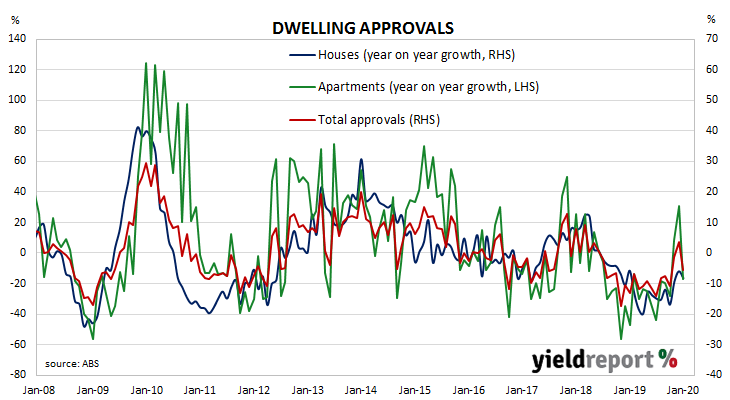Approvals for dwellings, that is apartments and houses, had been heading south since mid-2018. As an indicator of investor confidence, falling approvals represent a worrying signal, not just for the building sector but for the overall economy. Approval figures from November and December represented a substantial turnaround and the possibility of a recovery in 2020. However, the latest numbers have put the recovery scenario in doubt.
The Australian Bureau of Statistics has released the latest figures from January and total residential approvals fell by 15.3% on a seasonally-adjusted basis, much lower than the +1.0% increase which had been expected and a substantial turnaround from December’s revised figure of +3.9%. On an annual basis, total approvals contracted by 11.3%, a significant deterioration from December’s comparable figure of +7.2% after revisions.
Westpac senior economist Matthew Hassan described the drop as “much sharper than expected”. He put it down to an unwinding of a previous spike in high-rise approvals and bushfire effects.
 The report came out before the RBA decided to reduce its cash rate target by 25bps. The reaction in bond markets was subdued in any case and domestic bond yields finished just a touch lower. By the end of the day, the 3-year ACGB yield remained unchanged at 0.45% while 10-year and 20-year yields had each slipped 1bp to 0.79% and 1.21% respectively.
The report came out before the RBA decided to reduce its cash rate target by 25bps. The reaction in bond markets was subdued in any case and domestic bond yields finished just a touch lower. By the end of the day, the 3-year ACGB yield remained unchanged at 0.45% while 10-year and 20-year yields had each slipped 1bp to 0.79% and 1.21% respectively.
Expectations of another cut in the cash rate target remained in place, although they were trimmed just a little. By the end of the day, April contracts implied a 73% chance of a 25bps rate cut, down from the previous day’s 76% while May contracts implied a 95% chance of a cut, down from the previous day’s 100%. Prices of July contracts implied a rate cut had been fully built in.

